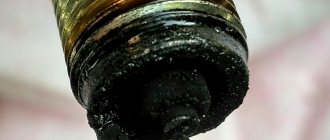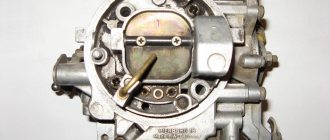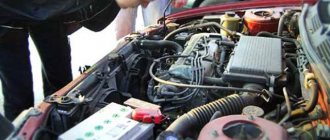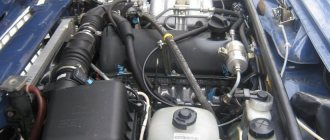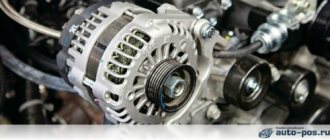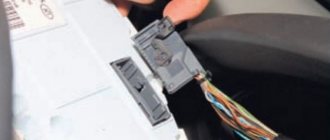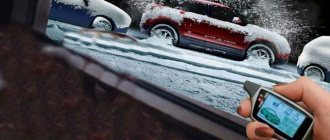If the car won't start
If the VAZ 2106 does not start, you must first identify the true reason. The probable causes of such a problem and possible ways to solve it are as follows.
- The car may not start due to faulty breaker contacts. To confirm or eliminate the risk of such a malfunction, it is necessary to check the condition of the contacts mentioned for the presence of gap violations or oxidation (burning) of the working surfaces. In the first case, you will need to adjust the gap, in the second, you will need to clean or replace the working surfaces. The compression spring will also need to be replaced if necessary.
- The problem may lie in the low voltage wiring of the VAZ 2106 car or in loosening (oxidation) of the wire terminals. You should check the wires going from the ignition coil to the distributor for breakdown and short circuit. There may also be problems with the ignition switch, which needs to be checked, and if it is faulty, it must be replaced or its contact group must be changed.
- There is a possibility of failure of the ignition coil, that is, the spark in the VAZ is lost. Perhaps the problem is a short circuit in the primary winding of this coil, which can be corrected by swapping high-voltage wires. If a spark on a VAZ 2106 appears in a place where it was not there before, but disappears on a new one, this indicates a fault in the spark plug wire.
- Problems with ignition distribution. The distributor capacitor may be broken; therefore, for normal operation of the car, it must be replaced. It also happens that the distributor is installed incorrectly, this leads to the car jerking during acceleration and then stalling.
Poor starting of the VAZ-2106 engine in the cold season
The main problem with starting an engine in winter is frost. Defects that are not noticeable in the cold season in summer complicate startup. Everything freezes, especially the lubricant in the gearbox and gearbox thickens. The fact is that the oil in the engine crankcase is changed after a certain mileage of the car, but the box is forgotten or considered unnecessary. Therefore, in order to somehow facilitate starting the engine, you need to squeeze the clutch all the way.
If the battery is left in the cold for a long time, then a problem will also arise. It may not be charged enough to crank the engine. In this case, you need to have some kind of additional power source or charger.
Hard starting or the engine may not start due to extremely minimal compression in the cylinders. There is a way out of this situation: you need to unscrew the spark plugs, pour five milliliters of oil into each cylinder with a syringe, crank the crankshaft with the starter several times, screw in the spark plugs and try to start. The oil will circulate throughout the cylinder, increasing compression briefly. It’s better if you take care of this in the summer by having the engine overhauled at a specialized service station.
Why does the car stall while driving?
As for the most common malfunctions that many drivers of VAZ cars encounter, the list of common reasons includes those that lead to the fact that the domestic car 2106 stalls while driving. Let's look at them in detail.
- Low quality of fuel used. This is where experts recommend starting to look for the source of the problem. If, when draining the old fuel and replacing it with a new one, you are lucky and the car starts, you can confidently say that you should not skimp on the quality of gasoline for your car.
- Candles. Often, after changing the fuel and the problem persists, that is, the VAZ still does not start, suspicion falls on the spark plugs. You should check their condition after they are unscrewed and, if necessary, replace them with new ones.
- Fuel filter. Very often, a clogged filter can provoke interruptions in the fuel supply, as a result of which the VAZ 2106 stalls while driving. To eliminate the problem, it is enough to replace the fuel filter.
- Problems with the air filter are solved using the same method as with the fuel filter. A clogged filter does not allow air to pass through, which leads to engine pressure, that is, a drop in power. This way, the combustion process of the mixture will not take place, and as a result, the engine will stall.
- The problem is the fuel pump. A faulty fuel pump causes the VAZ 2106 to stall or not start at all. Treatment is checking the pump followed by repair or replacement.
- Battery: oxidation or poor terminal contact. The terminals should be checked, and then the battery should be cleaned or replaced.
- If the engine stalls while driving and won't start again, the cause may be the generator, which is not providing a charge. And since the car is powered only by the battery and, as you know, it doesn’t last long, the car starts working on the battery until it is completely empty.
- In modern brands, the cause of breakdown can be faulty electrical equipment. With such a problem, it is better to immediately contact specialists, because without experience and knowledge, you can replace half a car, but not get rid of the problem.
This concludes the review of the reasons leading to the VAZ 2106 not starting or stalling while driving. Spare no effort, time and financial resources for the well-being of your car, and it will respond with high-quality and long-term service.
As a rule, the true cause of the breakdown is revealed quite simply. And even a car owner who does not have deep knowledge of vehicle repair can easily correct problems that arise that are accompanied by incorrect behavior of his car.
Cold carburetor car engine does not start
Let's consider the causes of the malfunction - why a cold (not warmed up) carburetor engine of VAZ 2108, 2109, 21099, 2105, 2107 cars does not start. The main culprits will be carburetors 2108, 21081, 21083 Solex, 2105, 2107 Ozone. It should be noted that there are also reasons why a car engine does not start in cold weather, but there is a separate article on our website to describe them. You should also pay attention to the ignition system (2108, 2109, 21099, 2105, 2107), power system, serviceability of the engine itself, etc.
Symptoms of the problem “A cold carburetor engine does not start”
— When the crankshaft is cranked by the starter, the engine does not start.
He shows no signs of life. There are no flashes in the cylinders. — The engine “seizes”, several flashes occur and it stalls.
Causes of the malfunction “a cold carburetor engine does not start”
— There is no fuel in the carburetor float chamber
After a long stay or in the heat, it evaporated. Pump it up using the manual pump lever on the fuel pump.
You can pump fuel into the carburetor float chamber using the manual pump lever on the fuel pump.
— The mesh filter at the inlet to the carburetor is clogged
Details of strainer filters for fuel purification of carburetors 2108, 21081, 21083 Solex, 2105, 2107 Ozone
— Sticking of the needle valve needle in the upper position, which locks the fuel supply
Details of the float chamber of the Solex 2108 carburetor
— The air damper does not close completely when the “choke” handle is pulled out
It is necessary to greatly enrich the fuel mixture during a cold start; if the damper does not completely block the cross-section of the first chamber or does not close tightly, the mixture is not sufficiently enriched because the air flow into the carburetor is too large and the engine does not start.
The air dampers of carburetors 2108, 21081, 21083 Solex, 2105, 2107 Ozone are completely closed
Check the serviceability of the drive parts. Adjust it.
“Adjusting the air damper drive of carburetor 2105, 2107 Ozone” The air damper may become stuck on its axis, or its control lever may jam. Find out the cause of the jamming (contamination, mechanical deformation) and eliminate it.
— The solenoid valve (EMV) is faulty or the fuel jet of the idle system is clogged
In the event of a malfunction, its needle can completely cut off the fuel supply at idle.
Solenoid valves for carburetors 2108, 21081, 21083 Solex, 2105, 2107 Ozone Carburetor solenoid valve design
Also, check how the valve is screwed in, if it is not tight, then tighten it, but do not overdo it, do not tighten it too much as you can crush the fuel nozzle inserted into it or, even worse, the seat in the carburetor cover..
On carburetors with an idle air system fuel jet holder, unscrew the holder and check if the fuel jet is clogged. Remove the blockage and blow it out with compressed air.
— “Suction” of foreign air into the carburetor
The image shows the probable culprits of the “suction” of foreign air into the carburetor 2108, 21081, 21083 Solex.
Places of possible “suction” of foreign air into the carburetor 2108, 21081, 21083 Solex
— The starting device is incorrectly adjusted
It should slightly open the closed air damper when starting the engine, increasing the flow of air into the carburetor, preventing the fuel mixture from becoming overrich during the first flares in the cylinders. Also, do not forget that the throttle valve of the first chamber of the carburetor must be slightly open to a certain clearance when the starter is cocked.
Starting devices for carburetors 2108, 21081, 21083 Solex, 2105, 2107 Ozone
— The needle valve of the float chamber is not sealed
A leaky valve causes fuel to overflow, the mixture becomes excessively rich, and the spark plugs are flooded.
Replace the assembly; rubber-tipped needles are commercially available. If you come across a normal one, you can forget about repairs for a long time.
Articles on the website on the needle valve:
Checking the needle valve with vacuum on carburetors 2105, 2107 Ozone, 2108, 21081, 21083 Solex
— Fuel level is incorrectly adjusted
As a result of incorrect adjustment of the fuel level in the float chamber or damage to parts of the float device (stop valve floats), the fuel mixture may become over-rich or, conversely, over-lean, and the engine will not start as a result.
Approximate fuel level in the float chambers of carburetors 2108, 21081, 21083 Solex, 2105, 2107 Ozone
Adjust the fuel level in the float chamber:
— The fuel or air nozzle of the main metering system of the first chamber is clogged
Remove the carburetor cover, unscrew the air jets, unscrew the fuel jets of both chambers, remove the diffusers. Wash them with acetone, clean them with a thin wire or wooden stick, and blow with compressed air.
GDS elements of carburetor 2105, 2107 Ozone
We carry out a similar cleaning on the 2108 Solex carburetor.
GDS elements of carburetor 2108, 21081, 21083 Solex
Notes and additions
Before looking for the reasons why a cold carburetor engine does not start, you should check the ignition system, as the engine may not start due to its malfunction.
Source
The cause of a stalled engine is the spark plugs
In 50% of cases, the problem is due to the fact that the spark plugs simply do not produce a spark. This failure occurs as a result of 3 reasons:
- contacts become clogged;
- plaque forms along the entire contour of the candle;
- malfunction when supplying voltage to the spark plug.
However, the most popular is still black carbon deposits on the spark plugs, which prevents the spark from appearing or causes it to work periodically.
Tip: if the spark plug set malfunctions, you will hear a “triple” sound that is uncharacteristic of the engine. In this case, the car will jerk strongly while moving. As a result, the engine will either stall on its own, or you will need to turn it off and turn the ignition on again.
If you see dirt on the surface of the contacts, this indicates the need to replace a low-quality type of fuel or check the serviceability of the oil supply systems. It is the oil supply adjustment sensors that can splash the spark plugs with it if there is a problem. Also, oil that appears on a set of spark plugs may indicate serious damage to components in the engine cylinders. Be sure to check the engine at a car service center. Otherwise, further operation may lead to expensive replacement of jet rods and even the entire set of pistons.
If you systematically use low-quality gasoline samples, you may find a red-brown coating on the contour of the spark plug. In this case, cleaning will not help - it is better to immediately replace the entire set after a new refill. If you find that the car periodically turns off at full speed, but starts easily even with clean spark plugs, then the problem lies in the electrical wiring.
Checking the contactless distributor
If the “six” is equipped with a contactless ignition system, then checking elements such as spark plugs, coil, and explosive wires is performed in the same way as with a contact one. The differences lie in checking the switch and the Hall sensor installed instead of the contacts.
Hall Sensor
The easiest way to diagnose a Hall sensor is to install a known working element. But since the part may not always be at hand, you have to look for other possible options.
Checking the removed sensor
During the test, the voltage at the sensor output is determined. We determine the serviceability of the element removed from the machine according to the presented diagram by applying a voltage in the range of 8–14 V.
Diagram for checking the removed Hall sensor: 1 - ignition distributor; 2 - 2 kOhm resistor; 3 - voltmeter with a scale limit of at least 15 V and an internal resistance of at least 100 kOhm; 4 - plug connector connected to the ignition distributor sensor
By placing a screwdriver in the gap of the sensor, the voltage should change within 0.3–4 V. If the distributor has been completely removed, then by turning its shaft, we measure the voltage in the same way.
Checking the sensor without removing it
The performance of the Hall sensor can be assessed without removing the part from the car, using the diagram provided.
Diagram for checking the Hall sensor on a car: 1 - ignition distributor; 2 - adapter connector with a voltmeter having a scale limit of at least 15 V and an internal resistance of at least 100 kOhm; 3 — plug connector connected to the ignition distributor sensor; 4 - car wiring harness
The essence of the test comes down to connecting a voltmeter to the corresponding contacts on the sensor connector. After this, turn on the ignition and turn the crankshaft with a special key. The presence of voltage at the output, which corresponds to the above values, will indicate the serviceability of the element.
Video: Hall sensor diagnostics
Switch
Since the formation of a spark also depends on the switch, you need to know how to check this device too.
One of the reasons for the lack of spark on the spark plugs may be a faulty switch
You can purchase a new part or perform the following sequence of actions using a control light:
- Unscrew the nut and remove the brown wire from contact “K” of the coil.
- We connect a light bulb to the resulting open circuit.
- Turn on the ignition and crank the starter several times. If the switch is working properly, the light will light up. Otherwise, the element being diagnosed will need to be replaced.
Video: checking the ignition system switch
The performance of the systems and components of the VAZ “six” must be constantly monitored. The occurrence of problems with sparking will not go unnoticed. Troubleshooting and troubleshooting does not require special tools or skills. A minimal set consisting of keys, a screwdriver and a light bulb will be quite sufficient for diagnostics and repairs. The main thing is to know and understand how a spark is formed, and what elements of the ignition system can affect its absence or poor quality.
What to do if there is no spark on a VAZ-2106 car? As is known, this phenomenon leads to the fact that the air-fuel mixture does not ignite and the engine stops starting. Therefore, you will have to look for the causes of the problem without fail.
On VAZ cars, and on the “six” in particular, the spark can disappear due to a variety of malfunctions. But in this article we will describe only the most common of them, and also give useful tips for identifying and troubleshooting problems.
The cause of a stalled engine is a power supply failure
In this type of problem, 3 reasons may be involved:
- Poor contact with the terminals of the new battery;
- Detection of poor contact or breakdown along the entire length of high-voltage wires;
- The appearance of malfunctions in the generator or ignition coil system of the car.
If the problem lies in damp high-voltage wires, then it is best to replace them completely along with the battery contacts. If the terminals make poor contact, you need to carefully clean them with sandpaper and try to reconnect them. If the generator is found to be inoperable, the problem usually boils down to problems in the following parts:
- Broken timing belt;
- There is a malfunction inside the housing of the unit itself.
A problem with the generator is easily detected when the corresponding indicator on the dashboard turns on. In addition, if there is insufficient energy supply, the backlight of the on-board panel will gradually fade, and a set of other diagnostic sensors will show incorrect values.
Advice: if when you press the gas the car jerks, then stalls and cannot start, then the problem is related to the failure of the ignition coils. It is best to replace these parts in a car service using special equipment.
From the list of reasons that are directly related to the car engine, you need to move on to problems that arise in the fuel and air supply systems, as well as malfunctions of components responsible for exhaust gas removal.
VAZ 2106 stalls at idle
Adjustment
Idle speed adjustment is carried out using 2 adjusting screws: 1st - the quality of the mixture and 2nd - its quantity (Fig. 2). By default, at the factory, adjusting screw 2 is equipped with a restrictive sleeve, which acts as a seal. Thus, the manufacturer indicates that the rotation of the screw is within the factory range. For complete adjustment and when it is not possible to adjust the idle speed, the restrictive sleeve is removed and the basic adjustment is carried out.
Use screw 1 to set the crankshaft speed to 900 min.-1. They can be checked on a special stand or using a tachometer located on the instrument panel.
Using screw 2, you need to achieve a CO2 value that falls within the range of values from 0.5 to 1.2%. A special device will help with this - a gasometer.
The rotation of screw 2 helps to change the crankshaft speed. In this case, we again adjust and set screw 1 to the value of the rotation speed within 900 min.-1.
The correct idle speed setting is checked by pressing the accelerator pedal and releasing it sharply. The crankshaft rotation speed should increase smoothly and without failure, and then decrease as well. The engine should not stall. If this happens or jerks are observed when you press the gas pedal, the setting must be repeated.
It is recommended to place the limiting bushings on the adjusting screws, focusing on the mounting lugs. After completing the idle adjustment, the engine should run stably.
gone missing
Check the condition of the contacts, the integrity of the central high-voltage wire and the resistance of the slider. The ELXX valve on the Azon carburetor may be faulty, the tube may have broken or fallen off. A carburetor malfunction is also possible.
How to setup
To adjust the idle speed of the “six” carburetor, a number of preparatory conditions must be observed. These include:
The operation is carried out only on the motor that has reached operating temperature (about 90 degrees Celsius).
The clearances of the timing valves and ignition contacts (with a contact system) must correspond to the required dimensions.
When adjusting the idle speed of a VAZ 2106 carburetor on a cold engine, the required result cannot be achieved. If there is no idle speed, it will appear only if the correct adjustment conditions are met.
If the VAZ of the “sixth model” stalls at idle, then to find out how to adjust the idle speed, you need to use the following algorithm:
The process of adjusting the idle speed on a VAZ 2106 car is carried out using two screws for adjustment, the first is the quality screw, the second is the quantity of the mixture.
In accordance with the factory parameters, the quantitative adjusting screw is locked with a sealed limiter sleeve. To carry out adjustments and when there is no idle speed on the VAZ 2106, the seal is removed and adjustment work is carried out.
Using a high-quality screw, we achieve a value of 900 rpm, checking the value with the tachometer readings.
Using the quantity screw, we use a gas meter to set the carbon monoxide value in the range of 0.6-1.3 percent. The circular movement of the adjusting screw changes the number of rotations of the crankshaft of the power unit.
In this situation, we re-fix the required crankshaft speed parameters with the first screw. If everything is done correctly, then when you sharply press and lower the accelerator pedal, the rotation value should remain stable.
If all operations are performed correctly, there should be a smooth increase in engine speed and the unit should operate stably.
Fuel supply faults
It is quite easy to find out that the car stalls while driving due to the engine being “choked” with the fuel mixture - during a long drive you will find that the signal of the sensor responsible for this function is constantly on.
Here the problem lies in low-quality fuel, which does not quickly “ignite” from the spark of the candles. It can also be caused by gasoline not meeting the requirements for the octane number specified in the vehicle specifications. If there are problems with fuel, the gas pedal will be pressed all the way, and the car will not begin to gain speed. In addition, the car will periodically stall when the clutch is engaged.
Another symptom indicating problems with fuel is the appearance of problems with the car after refueling. The problem is characterized by a rapid drop in engine power at full speed, as well as when constantly changing gears. The way out of the situation is to completely drain the bad fuel mixture, wash the engine and all the fuel system pipes.
Also, the car will constantly stall if there is an interruption in the supply of the fuel mixture. This may be due to contamination in the following system components:
- Dirt in the fuel filter;
- Problems with injector nozzles;
- Dirty throttle valves;
- Fuel pump power failure.
The main symptom of a malfunction of these parts is that there will be a gradual drop in the power of the car’s engine, after which the car will stall even after sharply pressing the gas pedal. If you do not release the clutch carefully when changing gears, this will also cause the engine to stall.
Checking the functionality of the ignition coil
Another part due to which the car does not start, or its engine turns poorly and fires, is the ignition coil. In it, high-voltage wires or the distributor cap usually fail. To prevent short circuits in this unit, you can slightly change its position and fix it at some distance from any other structural elements of the machine.
You can also diagnose the coil using a multimeter or ohmmeter. Your task will be to check the resistance of the primary and secondary windings. If the readings obtained turn out to be significantly higher than normal parameters, then it is better to replace the part, since it will be very difficult to restore its functionality;
Malfunctions in the air mixture supply system
Here the problem lies either in a clogged air filter or in the failure of the regulator responsible for idling the car. In this case, your car will stall all the time when you gain speed or when you release the gas when you release the accelerator.
To solve the problem, remove and inspect the air filter. If there is serious contamination or chips, replace it. To diagnose and replace the idle speed regulator, you will need the help of qualified car service employees.
The engine only runs on choke, why?
If a warm carburetor engine idles only on choke (with the carburetor choke handle pulled out), then most likely there is a malfunction in the carburetor, the ignition system or the engine itself.
Why does a warm engine only run on choke?
Because either the fuel mixture supplied to it is too lean, which does not allow it to develop the required power and, accordingly, maintain the idle speed within 600-800 rpm, or there is a violation of spark formation on the electrodes of the spark plugs, leading to incomplete or untimely combustion of the fuel mixture, which is so also affects its power performance.
The “choke” handle extended towards itself allows you to close (partially or completely) the carburetor air damper, which ensures forced enrichment of the fuel mixture by reducing the proportion of air in it and maintaining minimum idle speed.
The reasons for the engine running only on choke are related to the carburetor and the power system
Using the example of engine 21083 of VAZ 21083, 21093, 21099.
The carburetor idle system (IAC) does not work
The fuel mixture does not enter the engine when the vehicle is idling, either at all or only partially. Reasons: the CXX is completely clogged, the CXX fuel jet is clogged, the solenoid valve or the EPH system is not working, the correct position of the throttle valve of the 1st chamber or the carburetor air damper is not correct.
Cleaning the channels of the idle system of a Solex carburetor using improvised means
Read more about how to diagnose and troubleshoot the idle system of the Solex carburetor 2108, 21081, 21083: “The idle system of the Solex carburetor does not work.”
The fuel pump does not pump
The supply of gasoline to the carburetor is disrupted; the fuel mixture at the outlet is lean. Reasons: fuel system filters are clogged (in the fuel pump, fine fuel filter, filter on the fuel intake in the gas tank), the fuel pump valves are faulty, the fuel pump drive is not adjusted (the pusher is worn out).
Checking the fuel pump of VAZ 2108, 2109, 21099 cars
Damaged engine power system
Fuel from the gas tank is supplied in incomplete quantities or not at all. Reasons: system filters are clogged, the fuel intake in the fuel tank is clogged, fuel lines are damaged (broken, deformed).
“Suction” of foreign air into the carburetor
Excess air entering the fuel mixture through leaky carburetor seals leans the fuel mixture. Possible places for excess air to “suck in” are the gasket under the carburetor, the rubber o-ring on the fuel mixture “quality” screw, the o-ring on the EMC.
Places of “suction” of foreign air into the Solex carburetor
How to deal with this malfunction and find the place of the “suction”: “Suction of foreign air into the carburetor.”
The reasons for the engine running only on choke are related to the ignition system
The ignition timing is incorrectly set
Ignition that is too early or, conversely, too late does not allow timely ignition of the fuel mixture in the combustion chambers. In this case, the resistance to rotation of the crankshaft increases to such an extent that the engine can start and operate only on “choke”, which makes it possible to somehow compensate for the loss of power by additionally enriching the fuel mixture.
Ignition timing angles for VAZ 2108, 21081, 21083 engines
Parts of the ignition system are “broken”
A short circuit in the elements of the high-voltage circuit of the ignition system (spark plugs, high-voltage wires, distributor cover) leads to a disruption in spark formation on the spark plug electrodes. The spark periodically disappears and its strength decreases. This does not allow the fuel mixture to be effectively burned and the engine to reach the required idle speed. Power losses can only be compensated by forced enrichment of the fuel mixture by pulling the “choke” handle towards you.
Car exhaust system problem
The engine may also stall if the tubes responsible for removing gases are malfunctioning. At full speed, the car will quickly begin to “choke”, and pressing the gas pedal completely stops the engine. Malfunctions in the operation of the exhaust pipe system in 90% of cases are caused by contamination and clogging of the muffler. However, the catalyst may also fail.
In the first case, carefully clean the muffler and remove foreign objects from there. If there are problems with the catalyst, conduct a complete diagnosis of the exhaust system and replace this element.
Other problems
Both on the carburetor and on the injector, the main reason that prevents the engine from starting is problems with the starter. If it does not rotate, then you will have to figure out why. Possible breakdowns:
- winding break;
- solenoid relay failure;
- poor contact in the wiring;
- discharged battery.
Also, the car may not start due to lack of gasoline.
The ignition coil and lock will have to be checked if nothing else helps. When it turns out that the problem is in the first one, it is removed and replaced with a new one. In the second case, first of all, look to see if the wire has broken somewhere.
In the ignition system, the distributor is also a vulnerable element. Remove the cover from it - if it is damaged, replace it. You need to do the same with the slider and hall sensor.
In winter, condensation sometimes freezes in the fuel rail. Warming up with a hairdryer or blowing with a compressor helps.
What to do if cars with automatic transmission stall?
If your vehicle has an automatic transmission, then the problem should be found in the electrical supply. If you abruptly switch from one gear to another, or while switching gears while braking, the settings may be distorted, and the on-board computer will receive a signal to turn off the engine.
Also, models with automatic transmission may stall due to malfunctions of the hydrodynamic transformers of the gearbox. This problem mainly manifests itself during acceleration and requires urgent intervention from car service specialists.
The engine starts and immediately stalls
In the case of the 2106 VAZ model, the power plant may not start if the starter is working properly if the fuel pump does not function as it should. For this reason, too little fuel is supplied to the combustion chamber. The repair is as follows: remove the pump and install a new one.
Line blockage. The pipes supplying fuel to the engine sometimes become clogged - this is due to low-quality gasoline. They will have to be removed and cleaned - kerosene works well to remove plugs.
Blocked injectors. When previous suspicions are not confirmed, you will have to inspect these engine elements. They are cleaned in the same way as parts of the fuel line.
Short circuit of the power wires leading from the ignition to the spark plugs is another factor leading to the fact that the car will not start. Inspect the insulation - the breakdown areas are always black. If such damage occurs, you need to buy a new set of cables.
The car jerks while driving: we find and eliminate the cause
Almost every driver has encountered such an unpleasant situation when the car began to twitch during acceleration, at low speed, or even at the very beginning of movement. Experienced car enthusiasts say with confidence that such a problem can happen to any car, regardless of age and make. Jerks in motion can be observed both in the Chevrolet Niva and in any other car. If your car begins to jerk while driving, it is recommended to find the cause as quickly as possible and eliminate it in time.
Often, every driver can eliminate such an ailment without the help of specialists at a service station. Ignoring the problem can not only aggravate the situation, which will subsequently require expensive repairs, but also jerking the vehicle often leads to an accident. A faulty car is unable to start a smooth ride and then accelerate. A jerking vehicle not only instills fear and terror on other road users, but also knocks them out of the way. Next, let's try to figure out what can cause the uneven running of the car.
VAZ 2106 carburetor starts poorly when cold with suction
I have a problem. Before cleaning the carburetor, the DAAZ 2107-1107010 was idling at its top five, either at maximum or completely absent, the car had difficulty gaining momentum, in general, I often drove with my hand on the choke, BUT IT STARTED WITH A HALF-TURN. I washed it: it runs smoothly, without interruptions, without failures when hot, but it STARTS almost from the pusher. I disassembled everything except the damper drive. I cleaned it with a spray (in general, a lot of crap leaked out), I didn’t change the jets, I took out the float, barely breathing on it. IT'S SO DIFFICULT TO START IT'S HORRIBLE. It warms up a little and works like a clock. What could be the problem
The car is shaking, what should I do?
At the first stage, the machine is diagnosed. Let's say that you have a VAZ 2106 with a carburetor engine in your garage. Your car already shows signs of “illness” at the first stage of movement. Or the car started moving without any hassle, but when a certain number of revolutions was reached, the engine malfunctioned. All this will not give answers, but only creates questions, because anything can break. In any case, if unstable operation of the car’s power unit is noticed while pressing the accelerator pedal, the first thing you should do is:
Main reasons for difficult starting
Each of the car models, both domestic and foreign, has its own operating characteristics. The engine most often starts if one of the systems is not functioning well: ignition, power or starter. A clogged carburetor, worn distributor or insufficient battery charge are the most common causes of difficult starting.
The VAZ 2107 car in this regard is no exception to the general rule; it has all the features of carburetor engines. Difficulties related to hot starting or the car not starting after a long period of parking, all this happens quite often. Qualified diagnostics of the systems mentioned above will eliminate the causes and significantly simplify the life of the driver.
We eliminate jerks when the car starts moving
According to the number of reviews from owners of VAZ 2106 with a carburetor engine, it is the engine power system that most often poses a problem. Due to the breakdown of absolutely any element of the system, the stable process of fuel combustion in the cylinders can be disrupted. If an insufficient amount of mixture enters the cylinders, then the car in such conditions will not be able to produce the required power. Against the background of this problem, twitching will begin to appear.
Check the pipes, determine if there is any depressurization of the system. Measure the fuel pressure. If the indicator does not correspond to the norm, then further search for the cause should be sought in the pressure regulator, fuel pump. These actions must be performed not only with the carburetor system, but also with the injection system. If an injector is installed on a VAZ 2106, then in this version the ignition system is also connected. The cause of the car jerking can be absolutely any sensor that has failed. Perhaps in this case you will need the help of specialists, because all the work is complicated by the presence of an electronic unit.
Troubleshooting carburetor problems
Regardless of whether an EMC is installed or not, the procedure for cleaning the idle fuel jet is the same.
- Unscrew the plug holder or EMC.
- Unscrew and remove the fuel jet XX.
- Clean the central channel of the jet.
In order to remove the XX jet from the radiator body, you will need a 13-size wrench, but depending on the design, a 14-size wrench can also be used. After turning the EMC, remove the nozzle. If the center hole is clogged, carefully clean it with a thin wire or blow it out with compressed air.
Once the fuel jet center channel is clean, reinstall it.
Screw in until it stops and tighten carefully with a wrench. Connect the “positive” wire to the power terminal of the EMC
Start the engine.
Do-it-yourself carburetor adjustment for VAZ 2107
To make it easier to work with the carburetor, it is necessary to remove the air filter. Turn on the ignition, first removing the power wire from the EMC terminal. Touch the power wire to the valve terminal. A distinct click indicates that power is coming to the EMC input. In this case, the cause of the malfunction should be sought in the jet or in the carburetor itself. The absence of a click indicates that the fault is in the solenoid valve or fuse. To check the valve, connect the “plus” of the car battery to the terminal of the EMC, and the “minus” to its body. If there is no click, the solenoid valve is faulty and must be replaced.
If power does not come to the EMC input, the reason may be a faulty wiring or the need to replace an 8A fuse. If you have a standard fuse box, then this part is installed in the 9th cell.
Eliminate jerking when accelerating a car
If the VAZ 2106 begins to twitch when accelerating, then in this case it is necessary to carefully check the engine power system. The driver presses the speed pedal while driving, but the vehicle does not accelerate. By pressing the accelerator pedal, the driver provokes an increase in the amount of fuel mixture supplied to the cylinders. If this does not happen, breakdowns occur in a uniform manner.
We check all filters: fuel, air. A carburetor engine has 2-3 filters. We will not take into account the mesh in the neck, since it can only prevent the penetration of large particles. You should carefully check the filter that goes to the fuel pump. Often it becomes clogged with impurities, which ultimately prevents the free flow of fuel, causing the engine to starve.
Why is the VAZ 2114 8-valve injector difficult to start?
For some reason, it seems that many drivers of this model will be interested in the question of why the VAZ 2114 8-valve injector does not start well. Finding the cause of this phenomenon is not as easy as it might seem at first. This is due to certain difficulties in troubleshooting in this model, since injection systems differ from carburetor systems. The algorithm for identifying possible problems will be built differently, adapting to the design features of the machine.
We will try to consider why the VAZ 2114 8-valve injector does not start well in this work. In a short article it is impossible to consider absolutely all possible problems; there are some that can only be identified with the help of diagnostic equipment. But, nevertheless, we will try to analyze as many such situations as possible in order to help all VAZ 2114 owners decide what to do in such a situation.
Why might the engine be difficult to start?
You can look for the culprit in such a situation in several directions. Among them, the most important problems are:
- Malfunctions in the ignition of a VAZ 2114 car
- There is no pressure in the fuel rail of the 8-cl VAZ engine
- Air leak into the VAZ intake manifold
- Timing belt marks are misaligned
Engine diagnostics using spark plugs
Let's look at the first option, why the VAZ 2114 doesn't start well. To do this, unscrew the candles and look at their color. If there is black dry carbon on the candles, we can say that the engine has been running for a long time on a rich mixture, which covers the candles with black carbon.
Why does black carbon appear on the spark plugs of an injection car:
- Malfunction of the mass air flow sensor
- The first oxygen sensor has failed
- Fuel pressure regulator is faulty
- Malfunction of fuel injectors
White carbon deposits on the spark plugs of an injection car appear due to a lean mixture, the reasons for the appearance:
- Everything is the same as with black soot
- Malfunction of the fuel pump or clogged fuel filter (check the mesh and fine filter)
- Air leaks through the air flow sensor pipe, the place where the regulator is attached to the XX joints of the manifold.
Checking the spark plug spark
The lack of a spark on one 8-cl spark plug of a VAZ engine will not affect the engine starting, it will be noticeable when idling, tripping and jumping revs. But if the ignition module of the VAZ 2114 is faulty, then the spark disappears in two cylinders 1-4 or 2-3. To check the spark plug spark, take out the fuel pump fuse, unscrew one spark plug or take a spare one, remove the high-voltage wires one by one, put them on the spark plug, then put the whole thing on ground (in this case, the valve cover) and ask a friend to crank the engine with the starter, so we check each spark plug. If there is no spark on one spark plug, most likely there is a defect in the explosive wires; if there is a spark in two or all spark plugs, it is highly likely that the problem is in the ignition module or the wiring to it.
Eliminate jerking when the car is moving steadily
If a Chevrolet VAZ 2106 exhibits twitching during stable movement, this most often happens due to problems with the ignition system. You can often hear car owners complaining that they just installed new spark plugs, but the engine has already failed. Detonation can occur even with new spark plugs due to incompatibility with the engine. If the spark plug fails, then the fuel will not burn completely, and breakdowns will begin in the operation of the power unit.
Checking the spark plugs is quite easy. The first thing you need to do is:
- Check the level of gaps on the unscrewed spark plugs. Check for any irregularities in the sparking process.
- A working spark plug produces a dark blue spark.
- If there is black carbon on the spark plug, then the problem may lie in a faulty ignition or faulty mixture formation.
If checking the spark plugs does not bring any results, you should check all wiring for oxidation and breakdowns. Don't forget about the coil and toggle switch. All elements of the ignition system, as in the case of a problem in the power system, are thoroughly inspected and checked for correct operation.
Causes of uneven engine idling
Experts divide the main reasons for rough idling into two categories:
- problems with fuel or fuel system;
- problems with electrical and electronic controls;
A malfunction of the air system (intake) can be considered separately, but it is more appropriate to include it in the list of problems with the fuel system. The fact is that both of them are inextricably linked and affect the stability of the power unit in idle mode and under load.
Fuel-air system and fuel. A poor fuel-air mixture is often the reason why the engine idles rough. Such a “poor” mixture is that there is too little fuel in it and too much air.
Excess air can be sucked in through damage in the line. For example, rubber fuel hoses of poor quality may initially have or acquire microcracks in their walls over time. Poor fixation of the hose also contributes to air leaks at the joints.
A more serious problem can be considered a problem with the idle air valve (also known as the idle air regulator, the secondary air regulator), which is sometimes called the idle air sensor. Owners of carburetor cars also know this part as the “solenoid valve.”
Excess air can also be sucked in through, for example, broken holes in the throttle valve axis on the carburetor. In this case, the problem may not become noticeable immediately: gasoline consumption will gradually increase, and interruptions in idling will appear.
Poor quality fuel. Because of it, the idle speed also often “floats”. This phenomenon is especially strong when using so-called eco-gasoline. It contains a certain amount of ethanol. Ideally, this not only makes the exhaust gases less toxic, but also helps clean the fuel system.
However, in practice, drivers either deal with counterfeit fuel, manufactured in violation of technology, or use such fuel incorrectly. The fact is that for normal engine operation of the specified “eco” type gasoline in the tank there should be no more than 40-50 percent.
The fuel pressure regulator (aka low pressure bypass valve) has failed. Its task is to maintain the required fuel pressure while the engine is running in any mode.
This breakdown is indicated not only by uneven engine operation at idle, but also by interruptions if you sharply press the gas pedal, a drop in power, and a strong increase in fuel consumption.
- The injectors are clogged (the channels are coked). Due to poor operation of the injectors, the fuel mixture is of inadequate quality in composition, which leads to disruptions in the operation of the power unit in different modes and increased fuel consumption.
- Air damper malfunction. This is usually a mechanical interference, which also leads to the formation of a poor-quality fuel-air mixture. As already mentioned, this causes the engine to run unevenly.
- The idle speed on the carburetor is not adjusted. In this case, under load the engine will operate normally, but at idle it will sometimes jerk, and at the same time there may even be a slight popping sound in the muffler. A relatively simple problem that you can deal with yourself by tightening the required adjusting screw.
Electrical problems
First of all, let's start with the ignition system. More precisely, the cause is too large a gap between the electrodes on the spark plugs.
Here the symptoms will be almost the same as with poor idle speed adjustment on the carburetor. The problem can be easily resolved by reducing the gap between the electrodes.
Unstable engine operation without load can also be caused by engine tripping. That is, one of the cylinders is not working.
In other words, the fuel-air mixture does not ignite. In turn, this phenomenon is due to a weak spark on the spark plug or its complete absence. Low compression in the cylinder is also possible due to damage, burnt valve, etc.
Power system malfunctions
The VAZ 2107 car engine is a proven and reliable unit. If the power unit does not start, the following problems in the power system are possible:
- The standard carburetor is clogged or the fuel level in the float chamber is not correct.
- The starter membrane is damaged.
- The tightness of the tube connecting the device to the vacuum brake booster is broken.
- Damage to the fuel pump membrane.
To eliminate the above listed malfunctions, the carburetor should be disassembled, followed by defective parts and cleaning of all jets and channels. During this operation, special attention is paid to the condition of gaskets and membranes. The car may not start normally due to air leaks in the absence of tightness between parts and damage to the lines.
The VAZ engine does not start well either hot or cold - the fuel pump may be faulty. In this case, the carburetor does not receive the required amount of fuel, which leads to a lean mixture. As a result, the power unit does not start, especially after a long stay, when the fuel level in the float chamber is extremely low.
VAZ 2106 car does not start after repair
Often, one of the reasons is incorrectly set ignition timing. The phases in the gas distribution mechanism may be out of whack. In this case, the engine may not start at all, or work intermittently - the process of engine operation may be accompanied by sneezing.
To eliminate this, the piston of the first cylinder is placed at the top point of the end of the compression stroke. In this case, you should not set it in accordance with the labels. This is a four-stroke unit, and the marks in it coincide twice during the cycle. There is an old but effective method - unscrew the spark plug of the first cylinder, and cover the hole with a piece of rags. Then turn the crankshaft. The moment when the fabric plug is pushed out is just needed for ignition.
If the valve timing is out of order, the breakdown can be eliminated by setting all parameters to the factory marks.
Ignition system malfunctions
If the engine has trouble starting hot or cold, one possible problem may be intermittent sparking. Checking the serviceability of the ignition system includes the following operations:
- Inspection of spark plugs, high-voltage wires, distributor, ignition coil and other elements.
- Checking their installation correctly.
- Monitoring the state of the breaker contacts, the size of the gap between them and the ignition timing.
- Checking the functionality of the ignition system as a whole.
